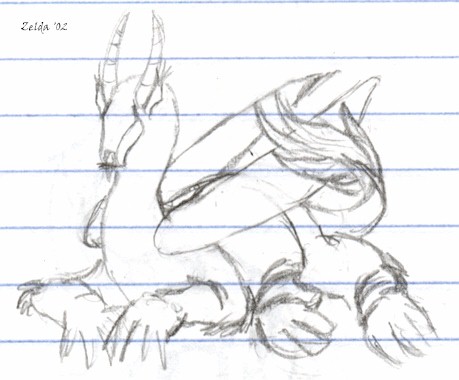|
|
|
Information
- The Good Guys
- The Bad Guys
- Other Characters
- FAQ
- Cast and Credits
- Official Press
- Tour the Pond - Episode Guide
- Did You Know?
Multimedia
- Offical Pics
- Coloring Book
- Screengrabs
- Original Art
- How to Draw...
- Fan Gallery - Sounds
- Video
- Music Videos - Songs
Fanfiction
- The Dragon Chronicles
- Chronicles Characters
- Fan Archive - Fan
Characters
- Other Fandoms
Drake 1 - Desktop Icons - AIM Icons - Wallpaper - Soundscheme - Winamp Skin
Links - Links - International Links - Webrings
Extras - Forum - Sign Guestbook - Read Guestbook - E-mail Zelda - Save the Ducks - Timeline - Zelda's Rants
Copyright © 2002
Zelda

Line of Motion and Starting Frame
The first mark you should make on your paper is your subject's line of motion. This is VERY important for dynamic poses and action drawings. A line of motion is simply a line, often curved, that directs the flow of your subject's body.
Even though it's just one line, it's important to think of all the elements that will be incorporated into that line later. Tails and wings are excellent ways to convey a line of motion even when your subject is just standing still. Lines of motion can also be influenced by things like wind, instead of subject-generated motion. Take a look at the above drawing. The line of motion is the straight diagonal line. You can clearly see how the line of motion is reflected in the wing spokes, they all go in the same direction. The curved red line follows the spine, which adds a three-dimensional aspect to the original diagonal.

Once you have your line of motion down, you have to
start a frame, or a general sketch of where your subject's body parts will go. The order
that I frame parts out usually is the head first, then the upper body and forelimbs,
midbody, hindlimbs, tail, and wings/ears. Make sure to leave room for the wings when you
first plan out your frame, even though they're the last step! I find that creating a frame
is especiallu helpful when I'm drawing a subject from a front view. Above is a frame-out
for a character I created called Daggertooth. Notice how it looks so rough? Leave room to
change things around in your frame.
Now that you've created a frame, all of the elements of your subject are in plain view, not just in your head. If you need to, go back and make corrections to scale, line of motion, etc.